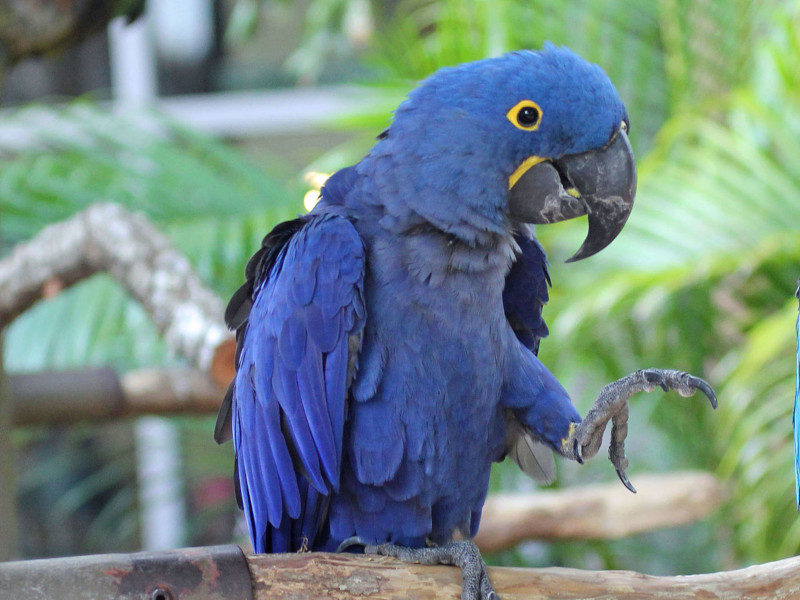
Hyacincth Macaw Facts
- The descriptive term of Hyacinth Macaw perfectly serves as one of the common names for a breathtaking variety of parrot. The beautifully colored avian also has another, less often used common name. That’s the similar term of the hyacinthine macaw.
- Its official scientific name, however, remains that of the extremely hard to pronounce term of Anodorhynchus hyacinthinus. By either of these names, though, it remains a most extraordinary, and visually distinctive, member of its particular genus.
- The first official recognition of the amazing animal as a separate and distinct species took place in 1790. This occurred at the hands of the respected English ornithologist, John Latham. At that time, however, he originally assigned it a different name.
- Quite sadly, its population numbers have plummeted dramatically in recent decades. Part of this occurred due to its popularity in the pet trade. Due to its greatly reduced numbers, the IUCN now lists it as Vulnerable on its Red List of Threatened Species.
- Luckily, the Hyacinth Macaw now enjoys some legal protection. It’s now covered by the Convention on International Trade in Endangered Species of Wild Fauna and Flora. Illegal collecting, however, still occurs within much of its native range.
- While the desire of humans to have it as a pet began the decline of its numbers, it now faces other perils. Habitat loss now forms a serious threat to it, given its natural range. The ongoing effects of climate change, though, now likely form its greatest threat.
Related Articles
Hyacinth Macaw Physical Description
Although perhaps best known for its great beauty, the Hyacinth Macaw stands out from its many related species for more than just that. It’s also extremely large for a parrot. In point of fact, this gorgeous bird ranks as the longest of all known types of parrot.
It’s not the heaviest, though. That distinction belongs to a flightless relative. Regarding its length, this avian attains an average length among mature adults of about 3.3 ft (1 m). This measurement extends from the top of its head to the tip of its large tail.
The stunning creature does not, however, display any noticeable degree of the physiological trait of sexual dimorphism. In this specific respect, it differs from many other birds. Thus, adults of both sexes reach the same average weight, that of 2.6 – 3.7 lb (1.2 – 1.7 kg).
The outward appearance of the Hyacinth Macaw, though, remains its most immediately obvious characteristic. Its feathers develop as completely blue, but lighter above than beneath. Yet it also has bright yellow rings around the eyes, and an area under the beak.
- Kingdom: Animalia
- Phylum: Chordata
- Class: Aves
- Order: Psittacifromes
- Family: Psittacidae
- Genus: Anodorhynchus
- Species: A. hyacinthinus
Hyacinth Macaw Distribution, Habitat, and Ecology
Most unfortunately, the awesome bird appropriately known as the Hyacinth Macaw only inhabits a small section of the world. Evidence indicates, though, that the beautiful bird once inhabited a significantly greater portion of its part of the world.
Currently, the vulnerable bird only appears in certain areas of the continent of South America. More precisely, known populations of the animal appear in the countries of Brazil, Paraguay, and Bolivia. But unfortunately, even there it mainly lives in scattered pockets.
This marvel of Nature also displays very strong preferences for its choice of habitats, as well as areas it avoids. Virtually all known individuals live in areas of either woodlands, palm swamps, and similar semi-open wooded areas. Meanwhile, it strictly avoids denser forests.
The Hyacinth Macaw evolved as entirely herbivorous in nature. Within its native range, its diet mainly consists of various nuts, such as Brazil nuts and macadamia nuts. Individuals also consume smaller quantities of such food as fruit, seeds, and other vegetable matter.
In temperament, it typically remains one of the gentlest and calmest of all related birds. Mated pairs usually nest between July and December, in a nest built either in a cavity of a tree, or on the face of a cliff. After mating, females generally lay 1 -2 eggs at a time.
Species Sharing Its Range
Check out our other articles on 5 Deceptively Dangerous Herbaceous Plants, Hector’s Dolphin, Bungle Bungles, Great Rhododendron, Woylie, Saint Francis’ Satyr Butterfly, Corsica
